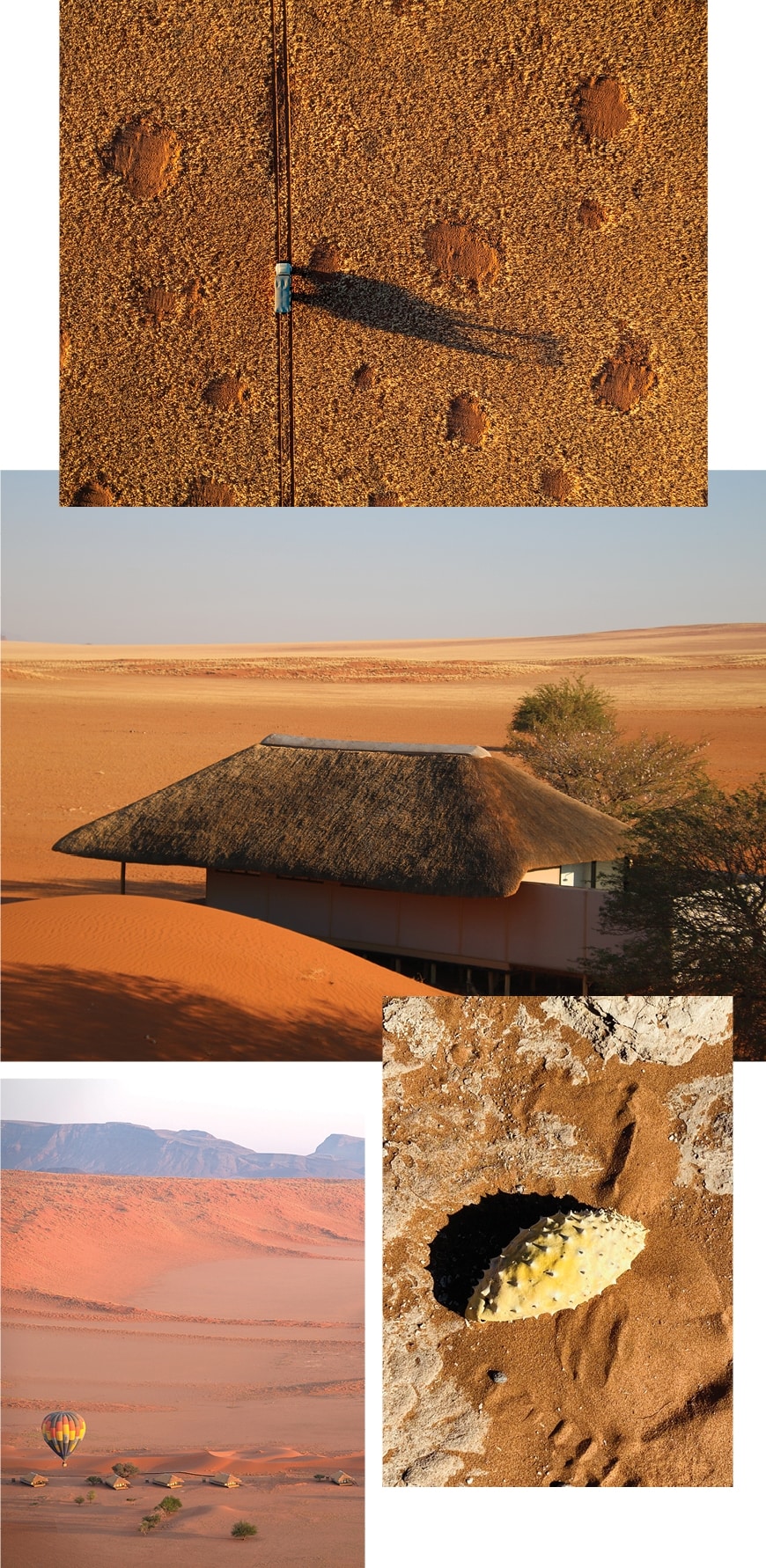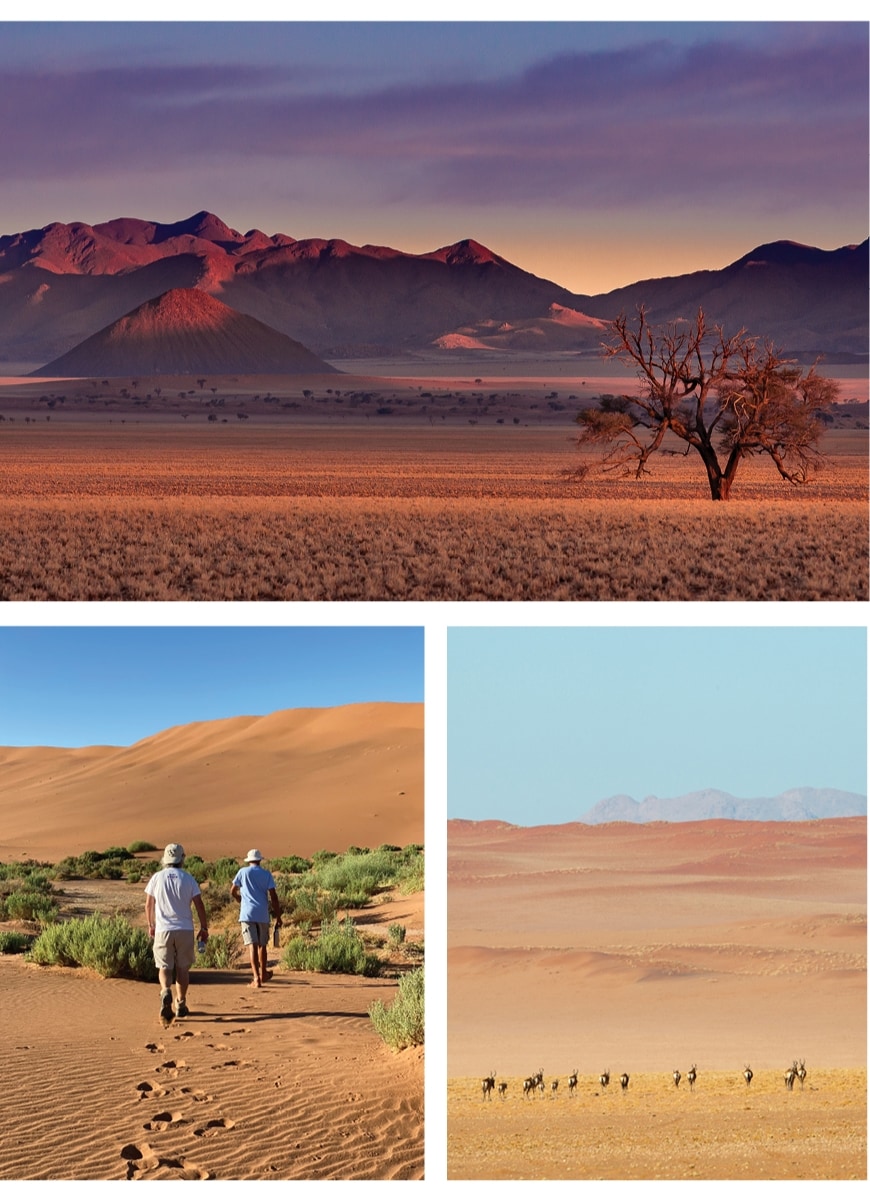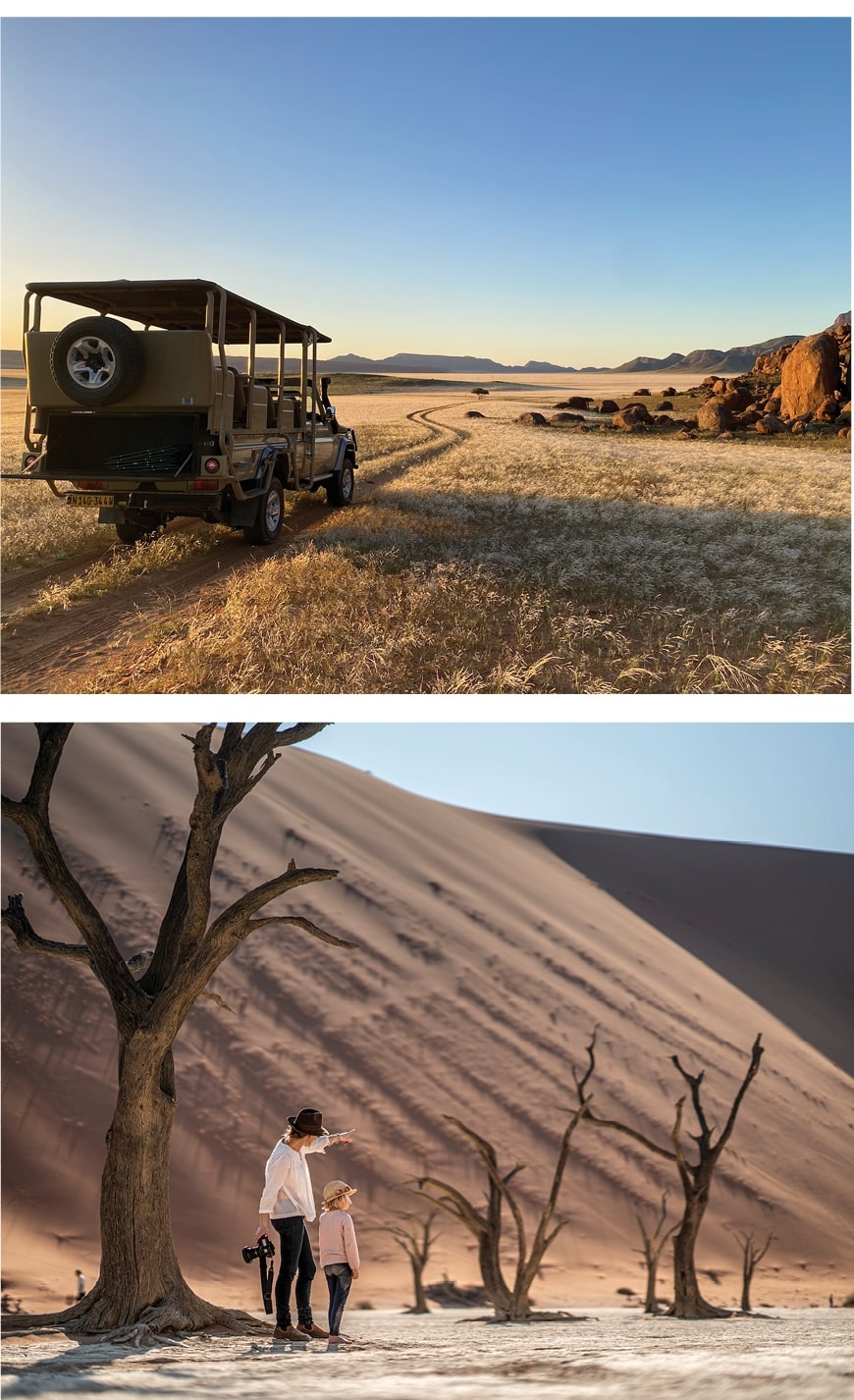By Anji Connell

Beyond Borders, Mad Max: Fury Road, Flight of the Phoenix, 2001: A Space Odyssey were all filmed in Namibia. Angelina Jolie and Brad Pitt’s daughter, Shiloh, was born here, and Harry and Megan had their honeymoon here — and no wonder Namibia is a hodiphile’s dream, an untamed wilderness with a raw beauty that makes your heart skip a beat. Its captivating landscapes fuel your wanderlust and feed your soul. It is exciting, exhilarating and unbelievably beautiful, with vast open spaces and limitless horizons. It’s otherworldly and pure geographical theatre — it’s the Disney world of nature. It’s also one of the least populated places on the planet, with a population of only 2 million. You can travel for hours through ever hanging landscapes without seeing another vehicle or building. And the best way to experience Namibia is by hopping from camp to camp via bush plane or by a 4×4 vehicle if you have more time.

No wonder Namibia is a hodiphile’s dream, an untamed wilderness with a raw beauty that makes your heart skip a beat


Our adventure begins with a magical two-hour flight in a small 35 seat plane from Cape Town—to Walvis Bay. The journey is spectacular [book your seat on the left facing] with a bird’s eye view of the incredible dunes and the Atlantic Ocean. We spend the night in Walvis Bay, departing early the next day on our 4×4 road trip to see the iconic red dunes of Sossusvlei. We travel through the Namib-Naukluft Park, Africa’s largest national park in the Namib Desert, a vast wilderness of over 200,000 hectares of unravelling desert plains, backdropped by the craggy mauve mountains and red dunes. It’s said to be the most beautiful desert in the world. It’s also the oldest, dating back at least 55 million years. This unforgettable and mesmerising journey takes around 5 hours, during which we pass the Tropic of Capricorn sign that marks an imaginary line of latitude connecting Botswana, South Africa, and Mozambique, and the quirky Solitaire, a tiny town that has become a “not to be missed” stopping off point. And you can’t miss it! It looks like a ghost town in the Wild West where the residents have just up and left or as if they were part of a desert movie set. A series of wrecked cars line the road. There’s a petrol station, a shop, a chapel, a guesthouse, and mom the most famous bakery in Namibia, the Moose McGregor Desert’s bakery, famous for its apple pie. We can vouch for its yumminess.
Soussusvlei and Deadvlei

Our destination is Kwessi Dunes, a tented camp on a private reserve of 15,000 hectares of exclusive desert terrain. And it’s spectacular! The recent heavy rains, the first in several years, has made the landscape more beautiful. The valley is bursting with bush and grass shimmering in the sunlight. Tiny white desert lilies poke through. The dramatic peaks of the Nakluft mountains rise up one side and the striking red dunes on the other! It’s absolutely breathtaking.
The camp is entirely solar-powered, and our room for the next two nights comes with a four-poster bed, striped canvas walls, and a “stargazer” room open to the dazzling starlight sky. Being enveloped in such a stunning environment is humbling.
We set off early the following day on the short journey to Sesriem, the gateway to the Sesriem Canyon, a natural gorge carved millions of years ago by the once-mighty Tsauchab River flanked by the magnificent and iconic red dunes. They are one of Namibia’s most impressive sights. Dune 45–the most photographed dune in the world due to its fascinating shape, but at 345 meters, Big Daddy rises tall, challenging you to climb to the top, from which you
see Deadvlei—an astounding area of eerily beautiful trees, petrified by centuries of little rain. The trees believed to have died 600–700 years ago are scorched black by the intense sun. It’s hauntingly beautiful. And if this is not enough, the following day, we set off at 4 am for a sunrise trip in a hot air balloon. We float over the wind-carved dunes, spotting animals roaming the plains and the mysterious fairy circles—hundreds of round patches that, despite much research and debate, their origin remain a mystery. Are they a result of poisonous fungi, termites, UFOs, or meteor showers? No one knows!
Swakopmund

So far, we have had the most incredible trip, and we are only just into our 4th day. We journey back up the coast to Swakopmund, “the tourist mecca of Namibia”. A charming seaside town is known for its wide-open avenues, colonial architecture, and quirky mix of German and Namibian influences.
Damaraland
From here, we set off inland to Damaraland and the Malansrus Tented Camp in search of desert-adapted elephants. We are in luck and spend a fabulous afternoon with them before returning to our camp for sundowners around the firepit.
We head to bed early as the journey to our next camp will be long and arduous due to the extensive rainfall that has washed the roads and bridges away. We are off to Hoanib Valley Camp on the banks of the Obias River in the Kaokoveld region.

On route, we visit a Himba tribal village whose way of life has changed little over the years due to their seclusion from outside influences. The OvaHimba are semi-nomadic livestock farmers who move around depending on rainfall and access to water. The Himba, especially the women, are famous for covering themselves with otjize, a mixture of butterfat and ochre pigment that cleans and protects their skin from the hot, dry climate and lack of water. It’s also considered a sign of beauty and signifies the earth’s rich red colour of the earth, blood, the essence of life. After several hours of visual overload, we arrive at Hoanib Valley Camp. Six sleek tents with sweeping rooflines sit above the valley grouped around a central open mess tent with breathtaking views of the rich orange sand and lush green vegetation—that again is due to the recent heavy rains, backdropped by metamorphic rock. The camp is gorgeous, open, and breezy; it oozes barefoot luxury yet leaves virtually no footprint on this fragile ecosystem. A downside of the extensive rainfall means the wildlife has fled! However, this place is so gorgeous. The staff are fabulous, and our guide is a delight. The staff’s warm smiles and joyous singing welcome us wholeheartedly. We are more than happy. We could stay forever—well, in my case, at least a week!

The Skeleton Coast


After two amazing days once again, we set off on our journey, this time with an escort overland to the Skeleton Coast National Park to Shipwreck Lodge. Our guide leads us through an array of ever-changing and ever more stunning terrain and finally through the Hoanib river bed to Shipwreck Lodge. We draw a breath—the camp sits on the southern bank of the Hoanib River, surrounded by the harsh beauty of the desert facing the thrashing Atlantic Ocean. Ten cabins and the main lounge/dining room designed by architect Nina Maritz resemble shipwrecks, with which the treacherous coast is synonymous. It sounds gimmicky, but it works. The sloping angles of the tilted windows and portholes further reinforce the nautical feel. We love it! The spruce timber design met the dual challenge of the remote location (much of it was assembled off-site in Windhoek, and it can be disassembled and removed, if necessary, at the end of the 25-year concession, leaving the land untouched.
The Skeleton Coastline has an eerily desolate and haunting beauty. It takes its name from the many shipwrecks of the many whale and seal bones that litter the shore. Over 1000 ships met their end here due to the infamous fogs and shifting sands. Some of which can be seen more than a kilometre from the ocean due to the shifting sands.
We had three nights here and enjoyed every second. From sundowner drives in the roaring dunes, an alfresco lunch on the beach, quad biking in the dunes and a trip to the Clay Castles, a fantastic natural geological formation. Again, due to the heavy rains, the wildlife has fled.Whereas we didn’t see the rare brown hyenas and desert-adapted lions, it in no way spoilt our experience.
We follow the coast to Swakopmund for the return journey, passing shipwrecks, an abandoned diamond mine, the remains of the Ventura Bomber, the Mowe Bay, and Cape Cross seal colonies—the world’s largest Cape fur seal population. We spend the last two nights in Swakopmund at the Strand Hotel on the mole, the promenade, acclimatising once again to an urban environment after the silence and stillness of the desert—and taking our Covid tests. We visit the flamingoes in the lagoon and the salt pans. We have a desert living nature trip where we meet the most amazing creatures—including the Namib Sand diving Lizard, the adorable web-footed Gecko, the Namaqua Chameleon, Peringuey’s Adder(Sidewinder). Our last morning sees us on a catamaran trip to see the Cape fur seal colony. We travelled with pelicans and seals, who hopped on board to accompany us on the journey to see the 100,000 or so seals creating havoc on a sandbank just offshore, entertaining us with their fighting and raucous barking; it’s quite a sight and extremely noisy. On the return trip, we sample the delicious local oysters and bubbles. It has been one heck of an adventure trip and an unforgettable experience. Namibia has to be seen to be believed.



Find out more about our hideaways in Namibia, click here.
Story written by Anji Connell @anjiconnell_acidplus


